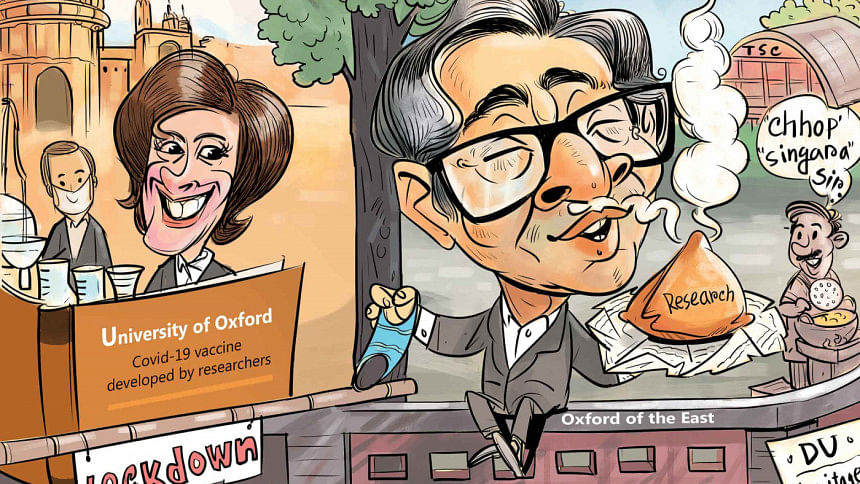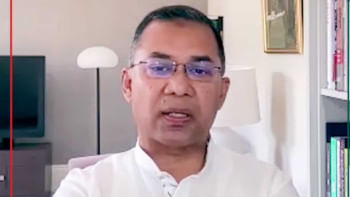Oxford of the East: A moniker that couldn't ring hollower

It has long been debated whether it is true that Dhaka University is the "Oxford of the East".
Former education minister Nurul Islam Nahid once said "this is just a saying". A few others also endorsed Nahid's remark.
Some academicians think the term "Oxford of the East" is used to glorify the successes in the university's early days.
The Quacquarelli Symonds World University Rankings 2022, released last week, placed Dhaka University (DU) in the 801-1,000 bracket while the University of Oxford in the UK was in the second position among 1,300 universities.
With such a gulf between the two and with DU's moniker in mind, a comparative analysis between the Oxford of the East and the University of Oxford in the UK can be revealing.
We can begin by discussing what the universities have been doing amid the coronavirus pandemic.
In Bangladesh, the first cases of Covid-19 were detected on March 8 last year. As the situation kept deteriorating, authorities of the Oxford of the East announced an indefinite shutdown of the institution on April 9 last year. The dormitories have been closed since.
The shutdown is largely still in force, although the university did hold some examinations. But all other academic activities remain suspended.
The university's state of lockdown is easily visible to anyone visiting the campus.
There is a gigantic archway that constructed by the Dhaka University Alumni Association at the university's entrance at Nilkhet.
When the country enforced the lockdown, the authorities put bamboo fences across the archway to restrict entries of vehicles.
Over time, the government withdrew the lockdown, but the university has not removed the fences blocking traffic to the historic campus.
Not surprisingly, over time, temporary kitchen markets have sprouted there.
The DU authority also set up fences on Fuller Road, where there are living quarters of the teachers and officers.
Many people jokingly said that the DU authority is trying to prevent coronavirus with bamboo fences.
A few months ago, when the DU authorities decided to hold examinations without resuming classes, the fences were removed.
But then, the daily new cases of coronavirus skyrocketed and the bamboo fences reappeared.
Besides the fences, the authorities also took another "important" initiative: They banned the general public from the Teacher-Student Centre (TSC) on campus.
The university's proctorial team used to patrol the TSC area and repeatedly asked "outsiders" through loud speakers to steer clear. Tea stalls and other temporary shops were also removed.
At that point, DU Proctor AKM Golam Rabbani tested positive for Covid-19.
Thus far, much of the coronavirus prevention measures of the Oxford of the East seemed to involve shutting down the institution, setting up bamboo fences and ousting tea stalls and vendors.
Dhaka University authorities started conducting Covid-19 tests at its laboratories on May 5 last year. But a few days later, testing was stopped with authorities saying the laboratory facility would be used for academic and research purposes.
"It's a university; not a hospital," Prof Akhtaruzzaman, vice-chancellor of the university, told The Daily Star on June 1 last year. "The lab apparatus we brought from our three departments need to be returned for their research purposes. The apparatus needs to be disinfected and reinstalled in their previous places. That's why coronavirus samples will no longer be tested."
The kits and Personal Protective Equipment (PPE) were supposed to be provided by the health ministry, and the university was supposed to bear the other costs of testing.
The university authorities had then said they needed at least Tk 15 to 20 lakh a month to do the testing, that bearing the expenses was difficult and an added pressure on the institution.
After authorities of the Oxford of the East stopped coronavirus testing for the masses citing unavailability of funds, they announced they would start testing only for its teachers and students, fixing the testing charge at Tk 1,500.
The teachers availed the facilities, but the students did not.
We now come to the University of Oxford in the UK.
Coronavirus was first detected in the UK in January last year, around three months before the first case was detected in Bangladesh.
The University of Oxford launched a mobile app for instant contact tracing on March 17, the day all educational institutions in Bangladesh were shut down.
A day later, a release claimed the scientists of the University of Oxford unveiled rapid testing technology. Two days later, they disclosed the roadmap for easily settable ventilators.
Later, in phases, the University of Oxford conducted multiple researches on different aspects of Covid-19. These included research into which types of people would be massively infected, the practicable actions that could be taken by parents of isolated children, how lockdowns would be implemented, how the virus would affect pregnant women, and the mental health of infected people.
Most significantly, the University of Oxford signed a contract with AstraZeneca to develop a vaccine that got approval on December 30 last year.
While the University of Oxford in the UK was conducting such researches, the Oxford of the East was busy fencing up its streets to restrict movement of outsiders.
During this time, the Oxford of the East issued nine press releases.
One was a condolence message from the VC, two were about leave extensions and one about the decision to take Zoom classes.
Two other press releases were issued about the donation to the Prime Minister's coronavirus fund (Tk 1.37 crore). Three other messages were on raising awareness of using face masks, telemedicine programmes and mental health assistance services over phone.
Let us now discuss the general heritage and impact of each institution within their respective environments.
The University of Oxford has around 14,000 researchers. It is roughly estimated that some 91 percent of its graduates get jobs within six months of completion of their studies.
About the Oxford of the East, we can recall a remark of Vice-chancellor Prof Akhtaruzzaman.
In a programme in January 2019, he said, "Our university has another pride. You cannot find a cup of tea along with a piece of chaap, shingara and samosa for only Tk 10 anywhere in the world. But it is available in our university. If the international community come to know of this, it could be placed in the Guinness Book of Records."
Considering the divergent paths of each institution since the Oxford of the East opened its doors just under 100 years ago, the gulf between the two is much more than the 8,000 kilometres that separate them physically.
To paraphrase a famous poem, it seems never the two shall meet.


 For all latest news, follow The Daily Star's Google News channel.
For all latest news, follow The Daily Star's Google News channel. 



Comments